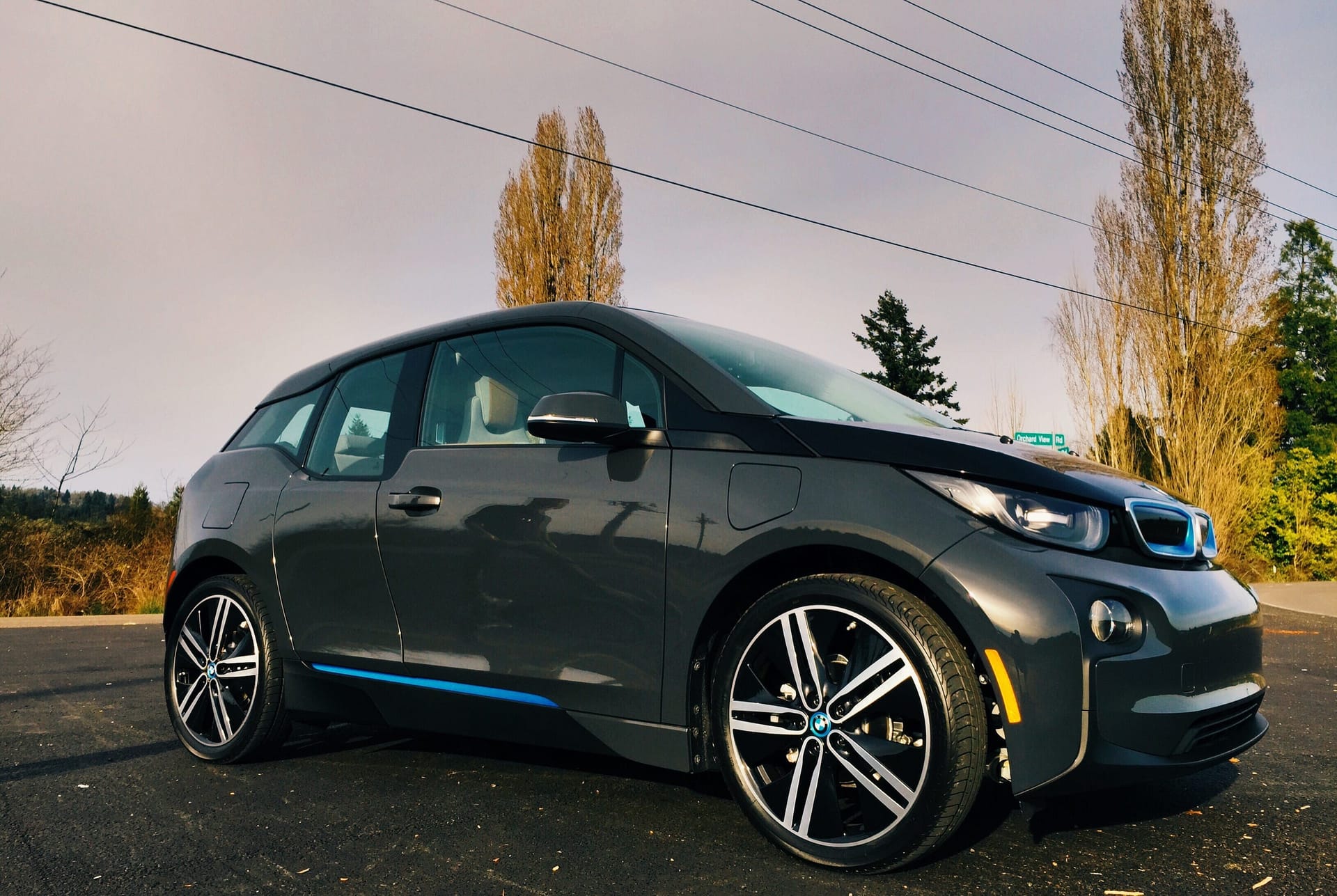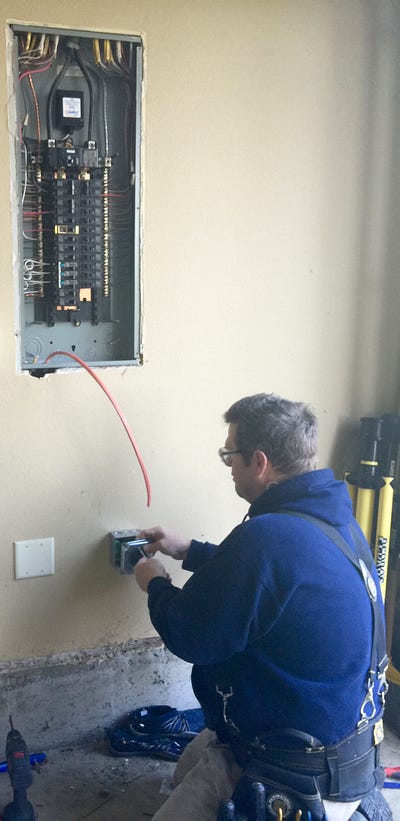Lessons learned from a month of EV ownership

I’ve lusted after a Tesla since they debuted, thought seriously about getting a Nissan Leaf too, but it was after I took a test ride in a BMW i3 that I found a perfect happy medium. I picked one up last month and learned plenty in the short time I’ve been driving it. If you’ve ever wondered what it’s like to live with an electric vehicle (EV), here’s a list of things I’ve learned since taking the plunge.
Lease, Don’t Buy
Batteries and technology are changing so rapidly in EVs that most cars are changing drastically every few years. For example, Nissan has already completely revamped their battery systems in the Leaf since 2011, offering a retrofit to early owners at a price of $5,500. Generally speaking, the prices are sky high for a brand new EV — a Leaf is pretty much a $30k+ version of their $13k Versa economy car. The i3 is basically the same size/utility as a Honda Fit, but costs $45–55k (about 3x as much). Nissan Leafs coming out of 3-year leases are being resold for around $10k, and it’s considered standard for EVs to drop to only 10% of their original value after just five years (aside from the Tesla S, which maintains a high resale value).
Even with tax breaks and incentives, owning an EV is a waste of money for something destined to change so quickly and depreciate overnight. Leases build in tax breaks and incentives to their costs, which results in Nissan Leafs running around $200 a month to lease for three years, and a BMW i3 about $250–350/mo for two year leases depending on car options. Similar EVs (Fiat 500e, VW eGolf, etc) all fall in this range. Expect to pay about ten grand over the life of a lease to drive an EV for a few years.
Let your friends actually drive it
I’ve taken half a dozen test drives as a passenger in different EVs, mostly from car makers doing demos and a few friends showing me theirs, but since I got my own, I make a point of showing everyone just how different an EV drives and how fast it can actually go by insisting they get behind the wheel of my car. Don’t be greedy, let your friends understand EVs from the driver seat, not as ballast in the passenger seat. You will convert almost everyone after they get a chance to drive one.
Charging Stations are Like Drug Dealers
Remember a couple years ago, when you saw special EV parking spots with charging cables springing up in cities? They were all free and rarely used, but now that there are thousands of EVs out there, most have gone to a paid membership/metered model and very few don’t charge you for the juice (“the first hit is always free”).

In this current wild west stage of EV charging, dozens of companies have sprung up to overcharge you for charging. In NW Oregon, electricity runs about 5 cents per kilowatt (some of the cheapest in the nation), and paid chargers run right around 50 cents per kW, or 10x the price of what they’re selling. The good ones charge per kW, but many ask for a flat fee of $5 or so, which could drive the cost over a dollar per kW if you’re not parked for several hours.
Remember: you can only recharge about 15 miles of range per hour at most public L2 chargers. There are faster DC chargers that can replenish 80% of a battery in a half hour, but those are rare, more expensive, and resemble hardware Thomas Edison used to electrocute elephants with.
The worst part is you need to sign up ahead of time for most of them. Your first visit to a charger will be a terrible user experience of being told to go online on your mobile phone to fill out a bunch of forms or call a number and give your credit card details to a stranger over the phone in a loud parking garage. Eventually, they’ll send key fobs and RFID cards to your home after paying/activating your accounts. My car currently carries four different charge network cards and my phone works for two more. It’s kind of nuts.
It’s not even consistent at the same types of locations — most every Walgreens in Oregon has a EV charger, but all the ones north of me use chargers from the Blink Network, while Walgreens that are south of me use the SemaCharge Network which my PlugShare phone app can act as a go-between. The fact that drivers are expected to know this and navigate this mess is crazy.
I don’t mind paying for electricity, but it needs to be greatly simplified and standardized, while currently it’s clearly neither simple nor standard.
Buy your own cheap charging station

Every EV you buy/lease on a lot will likely be offered with a branded charger for your home garage. They frequently run $1,000–1,500 for the charger before installation — don’t buy these from car dealers. Instead, you can go to Amazon and buy something like this perfectly fine level 2 charger for less than $600, and get a local electrician like the guy in my garage here to install everything for a couple hundred bucks.
EVs come with a standard 120v wall charger, but even with a small battery like my i3, it takes 10–20hrs to recharge the battery to full. In the first week I owned the car, I found myself gradually depleting the battery, as each night it couldn’t completely restore the power I used the previous day.
Getting a 240v L2 charger at home means you can refill your battery in about 3–4 hours and the difference between the wall plug and the faster charger was like going from dial-up to a cable modem connection. Being able to leave my house with a full battery before every trip makes driving an EV much easier.
You’ll save money
Thanks to living in the Pacific Northwest with its large hydroelectric power at Bonneville Dam, energy is very cheap. To replenish my car’s 22kW battery from 0% to full costs only $1.10. I never let it get that low, so typically it takes 3–4 days before I’ve racked up a full charge. I haven’t got enough electric bill history yet, but I’m fairly sure my home electrical costs will only grow by $20 per month. If you live in a place with more expensive juice, you can set chargers to operate in the middle of the night when rates are lower.
Compare $20/month to how much a full tank of gas costs, and how many times you need to refuel each month, and it’s pretty easy to see there’s quite a bit of savings to be had by going electric.
Range anxiety is real
Everyone talks about how few miles EVs get compared to their reported range, and it’s true that you’ll quickly find yourself freaking out over seeing the range dip by 10 miles when you’ve only driven 4 or 5. It’s also true the last 20% of the battery seems to last longer than you think, and most EVs have various “eco” modes that can help stretch your range.
My i3 is the REX model which comes with an emergency backup engine that runs a generator for the electric motors, adding about 40–50 miles of range, but after 1,500 miles I’ve only heard the engine run once when I tested the limits by driving 80 miles in a day without charging.
Public (paid) chargers are becoming ubiquitous and cruise control and eco modes can help, so you kind of have to get over the anxiety. Plus, it’s a city car! It’s not meant for road trips, so don’t try taking them, just putter around your town and you’ll quickly find it’s perfect for just that.
Hope you like apps
I scoured EV owner forums and found the general advice was no single phone app is perfect for finding your next charger, since there’s no standardization among networks, locations, and status of chargers. I’ve tried out a dozen EV charger mapping apps and after lots of testing whittled down the choices to my favorites:
PlugShare
Available for both Android and iOS, Plugshare is part Foursquare clone (you “check in” to a plug, share photos of locations, and people report broken chargers quickly), part Google Maps for chargers, and part social network. You can also pay for some charge stations using the app itself with a stored credit card. I especially like their maps for being the most comprehensive and up to date, as well as offering extensive custom filtering so if you can only use one type of charger, you can hide all the results you don’t need automatically.
ChargePoint
This is a good mapping application for finding chargers that also is part of one of the larger networks. Even the free chargers are often part of a charge network and chances are you’ll need to join ChargePoint just to unlock a city library’s complimentary charger. For many paid stations this app will work in leiu of a card or keyfob as well.
Your car’s official app
My BMW has a nifty app that remotely tracks the battery levels, location, and shows a history of my driving. It lets me lock the doors and honk the horn and will happily show me directions to find where I last parked it. Nissan Leafs have a cool companion app as well. Whatever app the company producing your EV makes, you should download it for all the extra features generic EV apps can’t match.
It’s a city car for quick trips (have a backup gas guzzler)
I grew up in Southern California and drove hundreds of thousands of miles before I turned 30 years old. Each time I left home I was potentially setting off on another epic road trip. I used to scoff at the common statistic thrown around that ~90% of car trips are less than 3 miles until I had a child and lived in a small town and realized: it really is true. Almost all my driving is only a mile or two in any direction. A couple times a week I might drive 30 miles away. It’s rare for me to go beyond that.
It’s good to have a backup option, and my family is going down to two cars, one being this EV, the other an efficient regular car for road trips, weekends away, and hauling lots of bike gear that won’t fit in the i3. If you live in a compact city, an EV is really the perfect vehicle to get around with.
Re-Learning to Drive
EVs differ from regular cars of the past. The BMW i3 has aggressive regenerative braking, which means any time you lift your foot off the gas pedal, the car starts generating power by engine braking and will slow the car eventually to a stop (while automatically running your brake lights). It means you can’t really coast in most EVs and you learn to start lifting off the gas pedal just before stop signs to a perfect stop on its own, and you learn how to keep a toe on the gas pedal to maintain speed (or better yet, use the smart cruise control systems built into most EVs). It takes some getting used to and might turn some drivers off, but know going in you will need to re-learn a few habits you’ve had for decades. It also means you’ll barely need to use your EV’s brakes.
A whole new world of etiquette
EVs are a new thing in American culture and given the last 100 years of mostly stable car culture, how we interact with automobiles is about to drastically change.
Charger etiquette is an entirely new thing. If you pull up to a public charger which is being used, but the meter says the battery is full on the car using it, should you unplug and use it in your car? (kind of like an apartment building with only one washer/dryer and your neighbors putting your clean, dry underwear in piles on the dryer so they can use it)
Not so fast! Locked/alarmed cars mean the chargers are locked into the cars and can’t be swapped, so what are you to do? Some charger systems text you when charging is complete and remind you to unplug, while some charge network apps let you text the driver to ask them politely to share the plug.
What happens in company parking lots with two chargers and four employees that drive EVs? Do they use interoffice email to bug one another to share?
How do EVs safely interact in downtowns filled with pedestrians while emitting almost no noise? (I’ve already almost hit two people and it sucks)
I’m sure something resembling common, courteous behaviors will emerge soon, but some of these things still seem up in the air.
The future is here and now, this is merely a preview
The 2014 BMW i3 has an available self-driving option (sadly, mine didn’t have this feature). All the things you’ve read about the future of self-driving cars is already here and actually came out last year in this model. Below 25mph (legally mandated), the i3 uses a series of cameras to follow cars ahead and behind you, and uses lane departure technology to steer, turning into a robo-car. I can’t wait for a driverless car future and it will change American society in massive ways, but know that the basic underpinnings of it are already available in consumer cars and it’s only a matter of years until it becomes the norm (and we no longer need to buy or lease cars that sit in our garages each night and instead rent space in them by the minute).
They’re really fun
Electric vehicles can provide 100% of engine torque from a standstill. This is what makes a Tesla Model S P85D the fastest four door production car on the planet. Even small city cars like the i3 are reportedly faster from 0–30MPH than BMW’s 3-series sports cars. You stomp on the gas pedal, and the thing really goes — it’s like a hopped-up golf cart and they’re really a blast to drive.

EVs also mean car designers have a new blank canvas to work from. Look at the picture above of my i3's interior. As a friend said, it looks like a W Hotel’s lobby on wheels. There’s no transmission tunnel, so the space between the seats can be used for storage. My dashboard is a series of floating tablet monitors and there’s no CD player or media input in the dash — it was designed mainly for bluetooth audio from phones. It’s all new and exciting and it’s good to see car designers bringing a sense of whimsy and utility into every aspect of these cars.
Electric cars are really handy, not that expensive, can save you a few bucks, and are killer little fun vehicles to move around your city. I implore you to give them a try someday soon.

Subscribe to get new posts in your inbox



